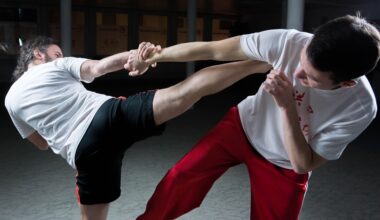Advanced Core Strengthening Movements for Experienced Athletes
For athletes looking to enhance their performance, advanced core strengthening movements can be game-changing. The core serves as the foundation of strength and stability, essential in virtually every sport. Traditional exercises such as crunches or planks are great but may not provide the challenge needed for experienced individuals. Instead, incorporating dynamic and functional movements can engage deeper layers of core muscles. Exercises like the medicine ball throw, Turkish get-ups, and plank variations can elevate core training to a new level. These movements mimic real-life athletic challenges and improve coordination, balance, and power. Focus on engaging the entire core, including the obliques, transverse abdominis, and lower back. This holistic training approach not only optimizes strength but also boosts overall athletic performance. Remember, as with any training program, proper form is crucial to avoid injury. The advanced level requires an awareness of your body and the ability to adapt as needed. Regular incorporation of these advanced movements into your training regimen will lead to noticeable improvements in your athletic performance and core strength.
Benefits of Advanced Core Workouts
Engaging in advanced core workouts yields multiple benefits, particularly for competitive athletes. Firstly, these workouts improve overall stability, which is crucial for maintaining balance and control during high-intensity athletic activities. Enhanced stability contributes to better performance, reducing the risk of injuries related to instability. Secondly, stronger core muscles facilitate more powerful and efficient movements. For runners, cyclists, and swimmers, this translates into better speed and performance. Furthermore, these workouts promote effective transfer of power from the lower to upper body, integral in sports involving bursts of speed or jumps. Incorporating progressive overload through advanced exercises also fuels muscle growth and metabolic rate, contributing to effective weight management. Additionally, heightened body awareness through advanced core training allows athletes to execute complex movements with precision and control. This translates into improved skills and techniques in their respective sports. Moreover, advanced core workouts can help in injury rehabilitation, providing targeted strength recovery. These benefits emphasize the importance of prioritizing advanced core movements in training routines for any seasoned athlete aiming to elevate their performance.
To effectively implement advanced core strengthening movements, athletes should consider a structured training approach. Firstly, incorporating a variety of movements ensures that all core areas are targeted uniformly. Using tools like stability balls and resistance bands can add an extra challenge to standard exercises. Secondly, athletes should aim for progressive overload, gradually increasing the complexity of their workouts. For example, transitioning from a basic plank to a side plank with a hip dip can significantly enhance difficulty. It’s crucial to keep workouts challenging to avoid plateaus. Moreover, incorporating functional movements that mimic specific sport activities can bridge the gap between training and performance. This practical approach solidifies the benefits of core exercises in real-world scenarios, improving not just strength but also agility. To maintain high motivation levels, switching up exercises every few weeks is encouraged. Allowing for recovery days is equally vital to prevent overtraining. Lastly, keeping track of progress through performance metrics can provide insights into areas of improvement. By adhering to these guidelines, athletes can enjoy a comprehensive and effective core training experience.
Key Exercises for Advanced Core Strength
Focusing on key exercises can significantly elevate the effectiveness of an advanced core training routine. Some recommended movements include the hanging leg raises, which effectively target the lower abdominal muscles while improving grip strength. The hanging position engages the upper body as well, solidifying overall stability. Another essential exercise is the medicine ball slam; it not only engages the core but also enhances power and explosiveness. The rotational aspect of these movements is crucial for athletes involved in sports requiring twisting actions like golf or baseball. V-ups are also a dynamic alternative to traditional sit-ups, activating both the upper and lower core simultaneously. Additionally, the plank to push-up progression challenges endurance while incorporating upper body strength training. Bridging movements, such as the stability ball bridge, can also increase glute engagement, enhancing overall fitness. Finally, the ab wheel rollout is an advanced exercise that dramatically improves core strength while requiring proper form to execute correctly. These exercises are not only challenging but also dynamic, ensuring that experienced athletes maximize their core training effectiveness and overall performance.
For advanced athletes, integrating stability challenges into core workouts adds an extra layer of difficulty. Exercises like the single-leg deadlift or the Bosu ball squat enhance core stability while demanding greater balance and coordination. Engaging the core while managing instability will lead to increased muscle activation and control. The use of balance boards can further amplify this challenge by forcing the core to stabilize dynamically during various movements. Implementing plyometric elements, such as jump squats or burpees, engages the core as a stabilizer during explosive movements, enhancing coordination. It is crucial to ensure proper technique during these activities to maximize benefits and prevent injuries. Furthermore, combining mobility work with strength training can lead to improved flexibility in the core and surrounding areas. Dynamic stretches and yoga poses, when incorporated with core exercises, foster a holistic approach to strength training. These practices help improve range of motion and core activation. To get the most out of workouts, athletes should always prioritize quality over mere quantity, ensuring they master each exercise before progressing further.
Tips for Progressing Core Strength
Progressing core strength requires a thoughtful and tailored approach for individual athletes. Regular assessments can help identify strengths and weaknesses in core stability, guiding training focus. Starting with a solid foundation is key; ensuring mastery of basic movements before introducing advanced variations is crucial for safe and effective training. Incorporating varying tempos, such as slowing down during eccentric phases of exercises, can challenge both strength and control. This method promotes better muscle engagement throughout workouts. Additionally, exploring different training environments, such as unstable surfaces or changing grips and holds, can introduce new challenges that further enhance core strength capabilities. Keeping sessions engaging and mixing up bodyweight exercises with resistance training can also contribute to sustained motivation and growth. Creating specific goals tailored to individual sports or fitness aspirations encourages athletes to stay focused and track progress over time. Lastly, incorporating recovery techniques such as foam rolling and stretching aids recovery, preventing fatigue from hindering performance. Overall, consistency, variation, and monitoring progress are essential strategies for any athlete looking to advance their core strength effectively.
In conclusion, understanding the importance of advanced core strengthening movements is crucial for athletes aiming for elite performance levels. The strategic integration of diverse exercises, progress monitoring, and recovery techniques is essential for maximizing results. Training should constantly evolve to ensure adequate stimulation and adaptation of core muscles. It is worth considering incorporating professional guidance in advanced training to optimize performance safely. Utilizing knowledgeable coaches can help tailor workouts specific to individual needs while maintaining focus on strength and injury prevention. Advanced core workouts not only enhance physical strength; they also cultivate mental resilience, key in competitive sports. Furthermore, consistent engagement with these advanced exercises fosters long-term athletic health, reducing the likelihood of injury over time. Adopting purposeful core training strategies can significantly impact performance across various sports. By prioritizing these core movements, athletes prepare themselves not only to meet but to exceed the demands of their respective disciplines. As core strength contributes fundamentally to overall athleticism, now is the perfect time for athletes to elevate their training through focused, advanced core exercises.


